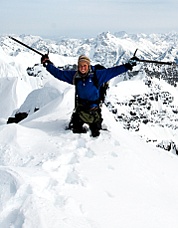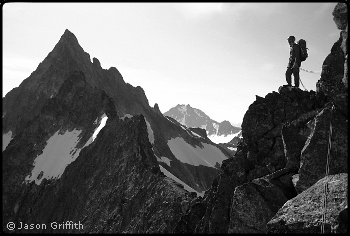 |
 he summer of 2009 was a busy and challenging season for wilderness
rangers at North Cascades National Park. The season was notable for its
hot and sunny weather, a dramatic increase in wilderness visitation, and
an intense period of search and rescue (SAR) incidents.
he summer of 2009 was a busy and challenging season for wilderness
rangers at North Cascades National Park. The season was notable for its
hot and sunny weather, a dramatic increase in wilderness visitation, and
an intense period of search and rescue (SAR) incidents.
June brought unseasonably nice weather, leading into one of the
busiest Fourth of July weekends on record. July and August continued the
trend of hot and sunny weather. The above-average snowpack melted
quickly, yet many routes remained in great climbing shape late into the
season.
An unusual number of powerful thunderstorms moved across the Cascades
during the summer, chasing climbers down mountainsides and causing a
flash flood on Boston Creek that washed out a section of the Cascade
River Road. Despite the unstable weather and dire predictions, there
were fewer wildfires in the North Cascades than expected. The Panther
Creek and Brush Creek Trails were closed for part of the summer due to
wildfires, and small fires of short duration were observed on Castle
Rock, Luna Peak and near Boston Basin and Newhalem. In addition to the
Brush Creek Trail closure, a large avalanche on Forest Service Road 32
(Hannegan Pass Road) prevented the road from opening until August; this
made access from the west to Whatcom Pass and the North Pickets
problematic for much of the 2009 season.
Climbing Visitation
The Wilderness Information Center reported a 24% increase in visitation
to the office and a 34% increase in the number of submitted voluntary
climbing registers over the previous season. For the past ten years,
visitation to ten cross-country zones has been tracked based on overnight
rermits issued. The table below (showing the number of registered
backcountry users, not the number of parties) illustrates increased
visitation to all zones except for the Sulphide Glacier. For the past
several years, rangers have been noting increased visitation to the
Southern Pickets, a trend that continued in 2009. (Note: This table
includes data published in previous issues of the NWMJ that has been
corrected.)
| |
2000 |
2001 |
2002 |
2003 |
2004 |
2005 |
2006 |
2007 |
2008 |
2009 |
| Boston Basin |
667 |
626 |
628 |
631 |
668 |
634 |
632 |
562 |
492 |
529 |
| Colonial |
35 |
52 |
104 |
47 |
36 |
87 |
54 |
83 |
90 |
95 |
| Eldorado |
471 |
460 |
493 |
435 |
467 |
358 |
499 |
536 |
443 |
538 |
| Goode |
72 |
57 |
47 |
75 |
21 |
17 |
35 |
18 |
21 |
46 |
| Klawatti |
76 |
98 |
76 |
60 |
42 |
28 |
55 |
76 |
61 |
96 |
| Logan |
58 |
67 |
53 |
57 |
26 |
27 |
43 |
54 |
41 |
77 |
| Sahale Glacier |
449 |
626 |
515 |
612 |
416 |
612 |
520 |
375 |
437 |
484 |
| Sulphide Glacier |
779 |
795 |
638 |
607 |
685 |
628 |
540 |
468 |
691 |
624 |
| Terror Basin |
23 |
67 |
45 |
55 |
36 |
57 |
81 |
52 |
98 |
113 |
| Triumph Col |
50 |
44 |
68 |
66 |
61 |
46 |
75 |
51 |
54 |
61 |
| Totals |
2680 |
2892 |
2667 |
2645 |
2458 |
2494 |
2534 |
2275 |
2428 |
2663 |
 Climbers cross the Inspiration Glacier. Photo © Lowell Skoog. |
|
 Mount Logan from the summit of Black Peak. Photo © Dan Hilden. |
|
 Steph Abegg on the summit of Mt Buckner. Photo © Jason Hummel. |
| Climbers cross the Inspiration Glacier. Photo © Lowell Skoog. |
|
Mount Logan from the summit of Black Peak. Photo © Dan Hilden. |
|
Steph Abegg on the summit of Mt Buckner. Photo © Jason Hummel. |
Staffing and Training
In 2009, two permanent, one term, 11 seasonal, and three full-time
Student Conservation Association rangers conducted patrols of nearly
3,000 miles of wilderness trails and off-trail terrain in the North
Cascades. Climbing rangers patrolled routes on Mount Shuksan, Eldorado
Peak, Mount Logan, Goode Mountain, Terror Basin, and the Boston Basin
peaks.
All wilderness rangers participate in two weeks of early season
training on topics including search and rescue, low-angle carry-outs,
high-angle technical rescue, snow and glacier travel, Leave No Trace
principles, trail and camp maintenance, and toilet maintenance. One
ranger was sent to the 40-hour National Park Service Technical Rescue
training at Canyonlands National Park, and two climbing rangers
participated in an interagency rope rescue training drill at Mount Erie.
Resource Monitoring
Each year, wilderness rangers conduct monitoring surveys of cross-country
zones, climbing routes, and campsites to identify areas in which human
use is leaving long-term, visible impacts upon the landscape. The
purpose of these surveys is to identify areas that may require future
efforts to restore them to wilderness standards. In 2009, rangers
surveyed the following cross-country zones: Torment Basin, Terror Basin,
Inspiration Glacier, Sourdough Mountain, and Mount Arriva.
Waste Management
Over the course of the 2009 season, rangers documented and removed 139
occurrences of human feces and/or toilet paper from the wilderness.
Improperly disposed human waste was most commonly found on the Sulphide
Glacier route of Mount Shuksan and on Eldorado Peak. To address the
on-going human waste problems on Eldorado, the National Park Service
installed a new composting toilet in the fall of 2009, located on a rock
outcropping at the base of the East Ridge (near the popular bivy site at
7200ft). Wilderness rangers maintained 19 other composting toilets
throughout the park as well as countless pit-style toilets. North
Cascades National Park continues its free blue bag program, and rangers
are investigating the potential for including alternative waste disposal
methods into its human waste management program in the future.
Glacier Monitoring
For the seventeenth consecutive year, the National Park Service monitored
four glaciers in North Cascades National Park for mass balance (net loss
or gain of ice). Jon Riedel, park geologist, reports that 2009 was one
of the worst years for glacier mass balance since the project began in
1993. All four of the monitored glaciers—North Klawatti, Sandalee,
Noisy Creek, and Silver—lost far more mass to summer melting than
they had gained by snow accumulation during the winter of 2008-2009. The
long term trend for all four glaciers has been rapid recession caused by
lower winter snowfall and higher rates of summer melting.
Search and Rescue Incidents
Rangers at North Cascades National Park responded to 18 incidents in
2009, of which 10 were considered major Search and Rescue (SAR)
operations. These included the evacuation of seven injured or stranded
climbers, one climbing fatality, one response to a personal locator
beacon distress call, and a multi-day search for a missing hiker. In
addition, rangers followed up on 27 climbing parties believed to be
overdue because they did not sign out after filing a voluntary climbing
register. The total emergency cost to the National Park Service was
$42,454, of which $15,401 was for helicopter SAR operations.
Five climbing rangers and two local pilots completed annual training
and proficiencies in helicopter short-haul rescue. This program, in its
fourth year at North Cascades National Park, enables rangers to
efficiently rescue patients in mountainous terrain. The short-haul
rescue program proved to be instrumental in 2009, with seven operational
short-hauls used to rescue injured climbers in remote areas. Notably,
most climbing accidents were reported quickly in 2009. That, coupled
with the constant availability of an on-call helicopter in Marblemount,
provided unusually rapid and efficient rescues throughout the season. In
most cases, injured climbers were rescued from technical and remote areas
within a few hours of the injury occurrence. Selected search and rescue
highlights are in the sidebar.
|
 |
| Search and Rescue Highlights |
|
• Mount Shuksan
On May 23, a guided group of three fell an estimated several
hundred feet while descending a gully on the summit pyramid
without protection. One of the climbers injured her ankle during
the fall. The other two climbers were not significantly injured
and began a slow descent of the Sulphide Glacier with the injured
climber. Climbing rangers on routine patrol of Mount Shuksan
were notified of the incident and picked up by helicopter lower
on the mountain. They located the injured climber and flew her
off the mountain; she was then transported to the hospital for
treatment.
• The Triad
On July 1, two unroped climbers were descending steep snow slopes
when one took a sliding fall of approximately 100ft, likely due
to his crampons balling up with snow. Unable to self-arrest, he
slammed into a rock at the bottom of the snow slope, which
resulted in an open leg fracture but stopped him just short of a
large cliff below. Due to the exposure of the site and limited
options for helicopter landing sites, responding rangers were
short-hauled into the site and out with the patient to a staging
site on the glacier below. He was then flown in the helicopter
out of the backcountry and transferred to an ambulance.
• Mount Terror
July 5-9: See feature story in this
NWMJ issue.
• Cascade Pass
On July 25, park rangers on patrol at Cascade Pass were alerted
by a climber that a party beginning the Ptarmigan Traverse needed
assistance. One climber had slipped on rock, injuring his ankle,
while a second climber had turned back and was showing signs of
hypothermia. A ranger accompanied the reporting party along the
alpine route to the injured climber, while another ranger located
and assisted the hypothermic man. During patient assessment of
the injured climber, a thunderstorm with heavy rains developed,
necessitating a delay of helicopter evacuation until the
following morning. With bystanders caring for the injured
climber, rangers hiked out for mission planning but found that
the Cascade River Road had washed out in a flash flood, stranding
dozens of visitors at the trailhead. This unusual event required
a “road rescue” with rangers and road crew clearing
enough debris to safely get a few people out and supplies in to
accommodate those that were stranded. Early the following
morning rangers short-hauled the injured climber out of the
wilderness. Follow-up showed the climber had multiple fractures
in his foot and ankle, and the hypothermic climber had fully
recovered. The road remained closed for repairs for several
days.
• Mount Torment
On August 9, two climbers beginning the Torment-Forbidden
Traverse had ascended most of the Taboo Glacier on approach to
Mount Torment’s southeast face and were negotiating a huge
gap between two sections of ice. When the lead climber moved
onto the upper section of glacier, a massive piece of ice broke
off taking the climber with it. A single cam device held his
40-ft fall, but he was fatally injured by falling ice. His
climbing partner was also hit by icefall but was able to scramble
to a location where he could call 911 with a cell phone. Park
rangers were transported to the scene via helicopter and
proceeded with a recovery of the deceased climber.
|
| |
|
 |




